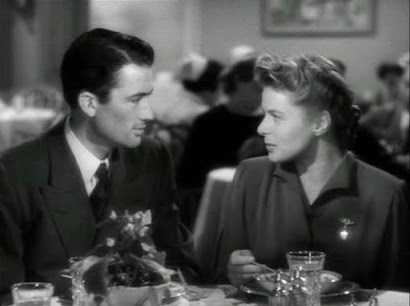Spellbound (1945) is a film noir with a psychological twist directed by Alfred Hitchcock. It stars Ingrid Bergman and Gregory Peck with a screenplay by Ben Hecht, based on the novel The House of Dr. Edwardes (1927) by Hilary Saint George Saunders and John Palmer writing under the pseudonym Francis Beeding.
 |
| Gregory Peck and Ingrid Bergman |
Dr. Constance Peterson (Bergman) is a psychoanalyst at Green Manors, a mental hospital in Vermont where she is perceived to be somewhat cold and aloof. Dr. Murchison (Leo G. Carroll) is forced to retire due to nervous exhaustion. When his replacement shows up in the form of Dr. Anthony Edwardes (Peck), Constance and the rest of the staff are amazed by that the hospital hired such a young director. Dr. Peterson is drawn to Dr. Edwardes, but she notices that things may not be quite right with him.
The film also features a dream sequence designed by artist Salvador Dali. William Cameron Menzies who also did the set design for the movie directed the sequence.
 |
| Bergman and Peck in part of the dream sequence deleted from the final cut. |
Alfred Hitchcock (1899 – 1980) was an English film director, producer, and screenwriter. He is one of the most influential filmmakers of the 20th century. Hitchcock directed over 50 feature films, many are classics that have been honored and studied for years. Some of Hitchcock’s classic films include The 39 Steps (1935), Sabotage (1936), Rebecca (1940), Suspicion (1941), Shadow of a Doubt (1943), Rear Window (1954), Vertigo (1958), North by Northwest (1959), and Psycho (1960).
Ingrid Bergman (1915 – 1982) was a Swedish actress who became an international star upon her Hollywood debut in Intermezzo (1939). Few actresses were as popular as Bergman during the 1940s. In fact, she was the number two box office draw (after Bing Crosby) in 1946. She starred opposite Humphrey Bogart in Casablanca (1942), For Whom the Bell Tolls (1943) opposite Gary Cooper, Gaslight (1944) for which she won the Best Actress Academy Award. She starred opposite newcomer Gregory Peck in Spellbound (1945) which was her first collaboration with director Alfred Hitchcock. Bergman would go on to win another Best Actress Academy Award for Anastasia (1956) and a Best Supporting Actress Academy Award for Murder on the Orient Express (1974).
Gregory Peck (1916 – 2002) was one of the biggest stars in Hollywood. He had three Best Actor nominations early in his career for The Keys to the Kingdom (1944), The Yearling (1946), Gentleman’s Agreement (1947), and Twelve O’Clock High (1949). He had non-exclusive contracts with David O. Selznick and Twentieth Century-Fox, which gave him great flexibility in the roles he chose to play. Other classic Peck film roles include Roman Holiday (1953), The Big Country (1958), The Guns of Navarone (1961). He finally won a Best Actor Academy Award for his iconic portrayal of Atticus Finch in To Kill a Mockingbird (1962).
The film features an excellent supporting cast including Michael Chekhov as Dr. Brulov in a Best Supporting Oscar-nominated performance, Rhonda Fleming in her film debut, and Norman Lloyd (still with us at 105!).
 |
| Theatre marquee when Spellbound was first released |
Spellbound Trivia:
- One of the first movies to deal with psychoanalysis
- Miklos Rosza’s score won an Academy Award
- Producer David O. Selznick wanted Dorothy McGuire and Joseph Cotton for the Bergman and Peck roles. All the actors were under contract to Selznick.
- Hitchcock’s first choice to play Dr. Edwardes was Cary Grant. His second choice was Joseph Cotton
To watch the film, click on the YouTube link below. Be sure to use this link because there are several prints of this film on the channel. This is by far the best.
After you watch the film, join us for a discussion on Zoom, September 29, 2020 at 6:30 p.m. Central Time. The invitation and Zoom links are below.
Stephen Reginald is inviting you to a scheduled Zoom meeting.
Topic: Discussion of "Spellbound"
Time: Sep 29, 2020, 06:30 PM Central Time (US and Canada)
Join Zoom Meeting
https://us04web.zoom.us/j/75223813893?pwd=Z3BiU2VFbVk4VVZTendjV01wektKUT09
Meeting ID: 752 2381 3893
Passcode: su4yZR
Discussion Questions:
- Hitchcock uses a lot of visual imagery in Spellbound. Did anyone visual (or series of visuals) stand out to you?
- What did you make of the psychological backstory?
- The Dream sequence was originally 20 minutes long but was cut down to about two minutes. Does it work and fit the narrative?
- Did the score of the film help or hurt it?
It takes your breath away
ReplyDelete